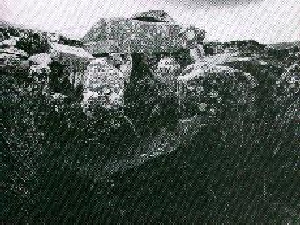Find out all about the top historical tombs to be found in Ireland. Used to bury the notable chiefs of the Milleniums BC or the unknown dead, each tomb carries historical significance for a particular area.
Kiltiernan, Dublin 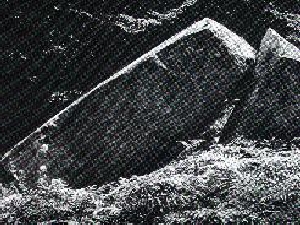
Borlase graphically described this rather ungainly portal-tomb as ‘a sphinx-like monster, advancing out of a rocky hill on some half-dozen short and rickety legs’. Its unusual shape immediately draws the eye, and it stands out boldly in a field which has many natural formations of large boulders. The 40-ton capstone is 22 feet long and covers an elongated chamber which yielded coarse Neolithic pottery. Immediately behind the tomb is a raised rocky ledge, and it has been suggested that the capstone was emplaced by sliding it from this onto the supporting uprights. The availability of a suitable slab of rock, especially a very heavy one, must have influenced the siting of many dolmens.
Kilmogue, Kilkenny 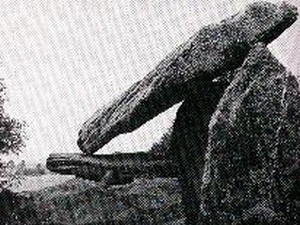
Situated 1/2 mile west of the crossroads hamlet of Harristown and better known in the locality as Leac an Scail, this is the tallest portal-tomb in Ireland. The monumental entrance to the chamber consists of two majestic orthostats each 12 feet high, with a massive door slab set squarely between them. The pitch of the capstone is unusually steep and its front edge soars out over the portals to a point nearly 15 feet above the ground. It rests at the back on a smaller, secondary capstone, laid horizontally across the side stones of the chamber. The double capstone is found in a number of south Leinster tombs and elsewhere. Because there is no officially recognised access to it, this noble megalith is unsignposted and forgotten, partly camouflaged by tall hedge in the corner of a field adjoining a farmyard, through which one must pass to reach it.
Knockeen, Waterford 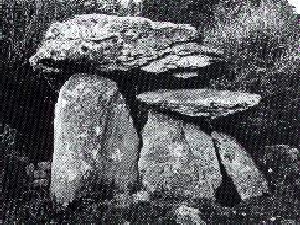
One of the most spectacular megalithic tombs of the distinctive south Leinster group, a stately Neolithic mausoleum, ‘remarkable’, to quote Borlase, ‘for its solidity, and the perfect carrying out of a unity of design’. As a scheduled National Monument it is entitled to better care than it currently receives. ‘It stands neglected in a corner of the disused burial ground of Kilburrin, 4 miles south-south-west of Waterford city, its great lichen encrusted stones emerging from a tangle of overgrown hedges. The size of this monument is quite astonishing when viewed at close quarters and it is evident that considerable labour must have gone into its construction, perhaps over a number of years. The paired portal stones reach the imposing height of 9 feet and have a heavy door-stone set between them to close to the porch-like entrance. There are two capstones, a feature peculiar to several portal-tombs in the area; the main one, a massive horizontal slab 12 feet long and 3 feet thick, rests on the portal stones and on the smaller capstone which covers the rectangular chamber.
Creevykeel, Sligo 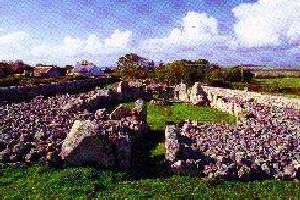
A magnificent, well presented full-court tomb, restored after excavation in 1935 and protected by a modern wall. One of the more accessible monuments of its type, it is situated at the rear of a cottage on the east side of the Bundoran-Sligo road, near the hamlet of Creevykeel. The long cairn is wedge-shaped and tapers sharply towards the west. The court, 50 feet in length, has straight sides and shallow curved ends. It is entered by an orthostat-lined passageway on the east.
At the west end of the court is the roofed entrance to a long gallery, divided by massive jambs into two chambers in which were found cremated burials and fragments of grave goods. In addition to the main gallery and to the west of it, are three small burial chambers set into the sides of the cairn. These are seemingly contemporary with the main tomb. The orthostats flanking the entrance to the gallery are impressively large, several standing 6 feet high, whereas those lining the remainder of the court are of much lesser size.
Lough Arrow Lough Gara Drive, Sligo 
Follow the signs for Carrowkeel, west of the village is Castlebaldwin, as the tar road gives way to a grassy track the stark, jutting cliff faces before you have a cathedral majesty which must have held a magic for the great Stone Age architects of these remarkable tombs. You leave the car at the apex of this track and climb by foot the short distance to the top of Bricklieve Mountain. All but one of the cairns you see scattered over the hillside are passage graves; the other covers a court tomb. On a nearby ridge is what appears to be the remains of an ancient village. The commanding views from this hill are spectacularly beautiful and you can appreciate to the full this glorious lake-studded corner of Sligo.
The road from Castlebaldwin to Carrowkeel is well signposted. Care should be taken, particularly when you leave the tarred road. After rain the surface can be slippery, and the narrowness of the track leaves little room for error. The wildness and excitement of the place will be better appreciated if you abandon the car in Castlebaldwin and walk the 6km to the tombs.
Poulnabrone Dolmen, The Burren 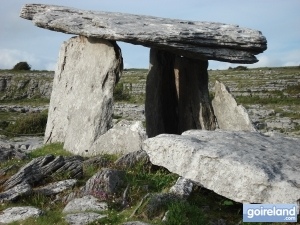
Rising like a bird about to take off from the karst limestone of the Burren, it attracts by its timeless simplicity, and consists of a very few upright stones (including, now, a necessary modern replacement) supporting a large flat capstone which rises from the back towards the front of the tomb. It is surrounded by a low mound, largely made up of stones, but it seems unlikely ever to have covered the whole monument.
Poulnabrone, means literally ‘the hole of the sorrows’, in a field beside the Corofin-Ballyvaughan road, is one of Ireland’s most photographed dolmens.
Disarticulated bones of 16 adults and children, equally divided between the sexes, were found inside-the remains of at least a part of the Late Stone Age farming community who erected this highly sculptural monument to themselves sometime in the 4th millennium B.C. An excavation in 1986 also unearthed a miniature polished axehead and a variety of flint implements.
Labbacallee 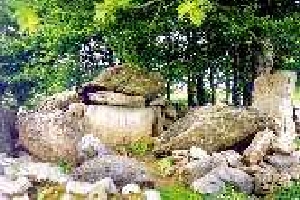
Translated as the Old Womans Bed, this Dolman is located outside Glanworth.
It is a huge wedge shaped gallery grave that dates back to the prehistoric phenomemon of Megalithic tombs.
Cloghanmore, Donegal 